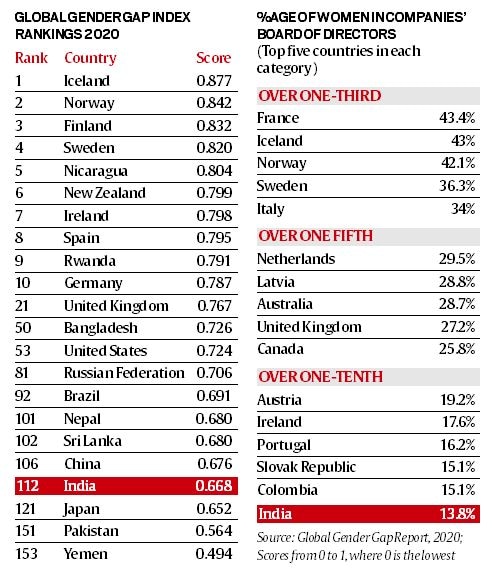Women in Workforce: Sociological Perspective
Relevance: Sociology: Patriarchy and sexual division of labour. Education and social change. & G.S paper I: Society and Social Issues: Women issues: Women Empowerment: G.S paper III: Economy
What’s in the News?

- Women workforce in the country fell to 18 percent in 2019 from 37 percent in 2006, non- government organization Azad Foundation reported on International Women’s Day (Celebrated on 8th of March every year).
- The World Economic Forum’s Global Gender Gap Report 2020 ranks India at 112th position out of 153 countries on economic participation and opportunity.
- According to the Foundation, the Global Gender Gap Report estimates that increasing women’s participation in the labour force can increase India’s GDP significantly.
- Research by Market Researchers has shown that in 160 largest companies in India only 6% of the companies have women in board chair positions.
-
What are the reasons behind the skewed figures for women in the workforce?
- The declining women’s labor force participation, gender pay gap, high rates of informal work with lack of social security are seen as impediments to the goal of gender equality and empowerment of women in India.
- There are multiple reasons for the fewer number of women in the workforce, from cultural reasons to security issues. However, a few of the most common reasons are:
-
- Significantly higher percentage of women tend to pursue higher degrees and accolades thus, increasing their duration of academics.
-
-
- Reports of the Human Resources Development Ministry and Department of Science indicate that upto 79 percent of the PhD scholars in India are women.
- Percentage of Under Graduate Degrees that women hold is about 56% and PhDs is 42% showing that the women are participating in education at all levels.
- According to the All-India Survey on Higher Education (AISHE) report 2018-19, the gender gap in the country has narrowed considerably from 2017-18.
- The decline in the number of women in the workforce is accounted for mainly by rural women, which can be attributed to the dwindling agricultural sector.
- The manufacturing sector hasn’t become robust enough to absorb the job losses caused by the decline in the agricultural sector.
- Smart cities, safer commuting options, a workforce and work setting plan which enables women to also raise families, are the primary drivers of the way women respond to working options in urban spaces, thus the lack of smart infrastructure options is another contributing factor to the number of women in the workforce.
- Stereotypes: Women are often discouraged to pursue or enter roles and positions due to gender based stereotypes, such as in combat positions in the army, or factory jobs that are thought to be male-dominated.
- Other times, when the man is in a good position to earn and take care of the family, the women are generally not encouraged to work. Thus the idea of women working is only with reference to the capability of the male dominant to support the family.
-
- The women also have to put in double the efforts as their male counterparts as they have to juggle a lot of things from home, family and the workplace. This makes managing workplace positions a lot more challenging for women, causing them to drop out of their jobs.
- Irrespective of employment category (casual and regular/salaried), organised or unorganised sector, and location (urban and rural), women workers in India are paid a lower wage rate.
What are the measures that have been taken by the Government?
- The Indian Government has taken several initiatives to empower women across the country.
- Policymaking in the country has been greatly influenced by the objective of encouraging more women to participate in the workforce.
- In recent years, government policies aimed at addressing the falling Female Labour Force Participation Rate (FLPR) have mainly focussed on launching employment programmes with special provisions to incentivise female employment such as Mahatma Gandhi National Rural Employment Guarantee Act (MGNREGA), Prime Minister’s Employment Generation Programme (PMEGP), MUDRA, diluting protective legislation, launching special skill training programmes, and heavy investment in programmes that support education of the girl child.
- They have extended the maternity leave period to 26 weeks of paid maternity instead of 12 weeks, granted under the Maternity Benefit (Amendment) Act, 2017. It also has other provisions which might make it easier for women to work, such as:
-
- An employer may permit a woman to work from home after the period of paid leave.
- Every establishment with 50 or more employees to provide crèche facilities within a prescribed distance.
- However, this Act has received scepticism on a lot of fronts.
- An advisory has also been notified to the state regarding the safety of women, specifically for travel, under the Factories Act 1948 by the labour ministry.
- Pickup and drop facilities for women working late will help create a strong infrastructure to create an enabling environment for working women.
- The Ministry of Women and Child Development (WCD) has launched an online platform that enables women employees working in both the public and private organisations to file complaints related to sexual harassment at the workplace. It is called as a Sexual Harassment Electronic-Box (SHe-box).
- It has been launched with an objective to ensure the effective implementation of the Sexual Harassment of Women at Workplace (Prevention, Prohibition and Redressal) Act 2013.
Why is it important to have women in the workforce, from a society perspective?
- Inclusion of women in the workplace provides for multiple advantages. From a corporate perspective, inclusion of women in the workplace would allow a different perspective or approach to a particular problem or issue.
- Employment for women also creates a balance in the gender gap, while simultaneously empowering women.
-
- It creates a mutual understanding between a couple, both of whom are working.
- It also raises the standard of living of the family as a whole.
How is women’s involvement in the workforce going to affect the economy?
- There are many reports which have indicated that a higher involvement of women in the workforce would have a tremendous positive impact on the economy.
- There are still a lot of workshops being conducted to engage women and to involve them into manufacturing and many other fields to empower them.
Issues:
- Lack of awareness regarding the opportunities: there is still an existing lack of awareness amongst women in terms of the opportunities that are available, particularly in the male dominated professions.
- Lack of proper education: women need to be encouraged to pursue education completely and learn to upgrade their skill set.
- Safety: the safety of women, and especially those who work late is one of the major reasons that both the family and the women itself, hesitate to work.
Way Forward:
- Over the last few years, more women have taken up Science, Technology, Engineering and Mathematics (STEM) courses and are aspiring to enter the workforce. However, dropout rates among women are also high, particularly around marriage, maternity, and motherhood.
- There are options like working from home, creches and so on, yet a lot more needs to be done.
- Considering the fact that 234 million people will join the Indian workforce by 2025, Gender Parity is more important in the Indian context. Increasing 10 percentage points of women participation in the workforce will boost India’s GDP by $ 777 billion by 2025 which will aid India achieve its goal of 5 trillion economy by 2025.
- Better transport infrastructure added with childcare facilities at or near workplaces will help women realise their full potential.
- Regular or periodical assessment and auditing of laws have to be ensured for better implementation of legislations to ensure the safety of women and also to ensure better opportunities for women as a workforce.
- Getting women into the workforce is not enough, it should be accompanied by their ascent to the leadership positions.
-
- It will help create a women-centric environment within the organisation.
Conclusion:
There are many efforts being taken by the Government to empower women into joining the workforce. This would have a positive impact on both the economy and the society. The government, however, has to ensure that the benefits of the schemes being implemented and the laws amended, reach every woman across the country.
For more such notes, Articles, News & Views Join our Telegram Channel.
Click the link below to see the details about the UPSC –Civils courses offered by Triumph IAS. https://triumphias.com/pages-all-courses.php

